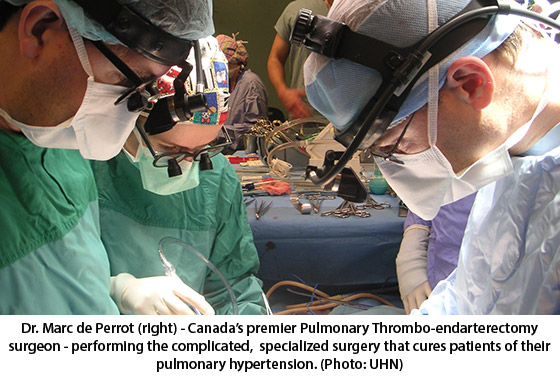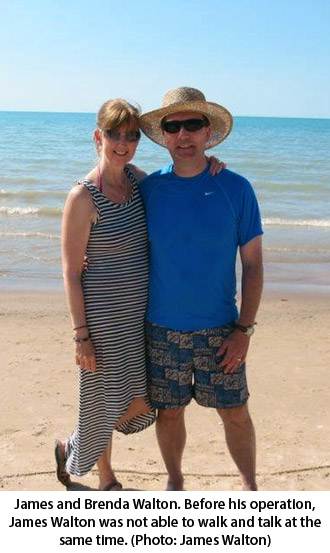
Things really came to head for Gordon Payne in the winter of 2005 when he bought a load of wood. The 68-year-old self-described 'ordinary guy' and farmer from Pontypool, Ont. had been ignoring his aches and pains and putting off going to the doctor.
“When I went to unload that wood, I just couldn’t do it; I felt totally sick and totally out of breath,” said Gordon.
After spending a week at his local hospital undergoing tests and taking pills to reduce the swelling in his arms, legs, feet, backside --- all over, doctors told him only half of his heart was working.
“I thought I was done for it and should settle up with my maker,” said Gordon. Then someone recommended a doctor who might be able to help him.
Enter Dr. Marc de Perrot, a thoracic surgeon at Toronto General Hospital. “He checked me over pretty good,” said Gordon who was diagnosed with pulmonary hypertension, a rare life-threatening disorder of the blood vessels in the lungs.
Perfect timing
Dr. de Perrot had spent the previous year in France training to perform the difficult-to-learn Pulmonary Thrombo-endarterectomy or PTE, a complicated and specialized surgery for curing patients with Gordon’s problem.
Initially, he didn’t think he could help Gordon, however, on August 30, 2005, Dr. de Perrot performed the first PTE procedure at Toronto General Hospital.
“It was risky, but someone had to be first,” said Gordon. “A few days after the operation, I was hooked up to batteries, walked the hall and was then pretty much ready to dance,” he added. Today, at 76, Gordon is going pretty strong; he still goes to market and farms a little.
The same year, Dr. de Perrot, now Director, Pulmonary Endarterectomy and Canada’s premier PTE surgeon, established a Pulmonary Endarterectomy Program at Toronto General Hospital.
The all-day PTE procedure requires expertise, experience and a team of specialized nurses and anesthesiologists. The body is cooled to about 20 degrees Celsius – half the normal body temperature to preserve organ functions – in order to safely stop the heart and lung circulation and drain the blood out of the lungs for 20 minutes. During that time, Dr. de Perrot uses a magnifying telescope to carefully remove the inner lining of all the tiny diseased blood vessels where scar tissue has developed.
Better than transplantation
“The surgery can be the alternative to a lung transplant and the outcome is much better. The PTE operation is the only cure for pulmonary hypertension; post-surgery patients are on blood thinners rather than anti-rejection drugs,” explained Dr. de Perrot.
 Shortness of breath and fatigue are two of the main symptoms of pulmonary hypertension. In its early stages, the disease may not be noticeable for months or even years. As it progresses the symptoms become worse. That was the case for James Walton, the 100th patient to undergo a PTE in March 2013.
Shortness of breath and fatigue are two of the main symptoms of pulmonary hypertension. In its early stages, the disease may not be noticeable for months or even years. As it progresses the symptoms become worse. That was the case for James Walton, the 100th patient to undergo a PTE in March 2013.
James was in pretty good shape, working out with a trainer, but his shortness of breath became extreme. After his diagnosis, he admitted that he wanted to cry after surfing the web and learning about the severity of the disease.
“The Province is lucky to have someone like Dr. de Perrot,” said James, who celebrated at his ‘Happy to see 50 birthday party’ in June. He added, “If someone doesn’t have access to this procedure they are going to die prematurely. The operation saved my life.”
Underdiagnosed
Dr. de Perrot believes that pulmonary hypertension is underdiagnosed and doctors don’t think of it or look for it. Hundreds of patients suffer from this disease across Canada every year.
Toronto General Hospital is one of 20 hospitals world-wide performing PTE surgery and the only hospital in Canada with a comprehensive Pulmonary Endarterectomy Program.
Dr. de Perrot has performed more than 100 PTE operations. Due to the success of the surgery, the number of PTE operations is rapidly growing. Currently one or two patients per week undergo this surgery at the Toronto General Hospital.
Most patients are from Ontario with a growing number from out of Province. The surgery, which was first performed in the 1960s, can now be performed safely with little risk. Patients are in hospital for a couple of weeks and feel the benefit of the surgery by the time they go home. The majority of patients don’t even need a blood transfusion. In the long term, patients are cured from this disease as long as they stay on blood thinners.
Related links
PTE brochure for more details about the operation
First Canadian procedure to treat drug-resistant hypertension 